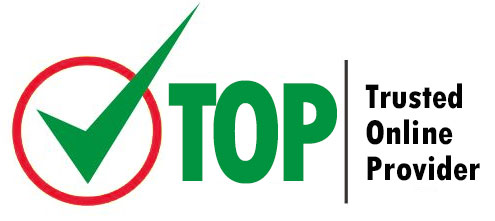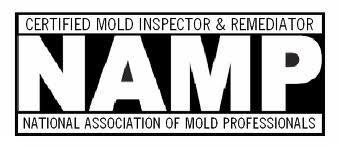Be A Certified Mold Inspector
NAMP (National Association of Mold Professionals) has developed a training and certification program to provide education and authoritative credentials for Mold Professionals.
This NAMP Certification course is America’s oldest and most respected certification course and is accepted in the United States & Canada!!!
Our NAMP Mold Inspector Certification course was produced in partnership with the NAMP - National Association of Mold Professionals. Dr. Edward P. Malone, M.S., CMI, CMR assisted as this subject matter expert. It is 6 approved hrs and you can print your certificate of completion upon finishing.
Get your Mold Certification Training Today!
We Welcome Corporate Accounts!
About NAMP
The National Association of Mold Professionals is a non-profit organization that was established with the goal of developing and promoting the Mold Inspection and Remediation industry. NAMP is America’s oldest and largest Mold Association.
NAMP also has an ongoing agenda of promotional activities designed to educate the public, and to instill the value of performing certified mold inspections as a perfunctory part of real estate transactions, after structures have been damaged by water, and any time health issues have become a concern.
As a plus, Mold Inspectors and Remediators consistently earn the highest income in the industry.
Online SchoolRoom (in conjunction with 360training) is a market leading provider of compliance and workforce e-Learning solutions. We, along with over 1500 e-learning partners, have trained more than 3 million users worldwide and were ranked in 2006 as one of the top 6 growing technology companies. Over the years we have had students from
- Trammell Crow
- Guaranty Bank
- Duke Energy
- IBC
After effects of hurricanes have led to environmental issues like MOLD and a large increase in the number & scope of environmental compliance imperatives. Mold Inspectors & Remediators consistently earn the highest income in the industry.
Online SchoolRoom All Rights Reserved
Mold Inspector Certification - Course Description- 6 hr course Mold Inspector Training for inspection and remediation
A NAMP certified mold inspector identifies potential mold infestation in a dwelling or building. Our program provides you with fundamental knowledge about fungi and the potential health risks of toxigenic mold. We teach you the different ways to inspect for/control mold infestation and how to ensure your safety during the process.
We will also explain the different tools and personal protective equipment used during the inspection process. For each area of a house or building, the course will show:
- what to inspect,
- how to access it,
- sampling methods to use if mold is indicated.
- explaination of the testing procedures
- legal requirements used by an AIHA certified laboratory
- how to interpret the results of laboratory testing.
A Certified Mold Inspector (CMI) is a specialist who has been professionally trained to assess both the presence of microbial contamination, and the source of any underlying moisture intrusion
At the conclusion of this course, you will be able to:
- Identify the services the NAMP Certified Mold Inspector provides
- Discuss the characteristics and health impact of Fungi and the criteria that indicate toxigenic mold
- Describe the ways to control mold
- Identify the tools and personal protective equipment used to detect mold
- Identify the areas and methods used to inspect in the exterior and interior of building assemblies, including foundations, roofing, basements, crawlspaces, attics & interior rooms
- List mold testing procedures and legal requirements
- Explain the interpretation of laboratory results
The NAMP certified mold inspector provides services to identify potential mold infestation in a house or building. This course will provide you with a fundamental knowledge about Fungi and the potential health risks of toxigenic mold. You will learn the different ways to inspect for and control mold infestation, while ensuring your safety during the process. This course will explain the different tools and personal protective equipment (PPE) used during the inspection process. For each area of a house or building, the course will detail what to inspect, how to access it, and the sampling methods to use if mold is indicated. The course will also explain the testing procedures and legal requirements used by an AIHA certified laboratory. Last, you will learn how to interpret the results of laboratory testing.
NOTE: This course was produced in partnership with the NAMP - National Association of Mold Professionals. Dr. Edward P. Malone, M.S., CMI, CMR assisted as this subject matter expert.
News from NAMP
Sample Job Duties and Responsibilities of a NAMP Mold Inspector:
- Determine the source(s), location(s), and extent of mold growth within a residential or commercial building.
- Determine the condition(s) that caused the mold growth.
- Visual inspection of all building materials within a residential or commercial building, including attics and/or crawlspace utilizing appropriate equipment: Infrared Camera, Moisture Meter, etc.
- Photograph water and/or mold damage found
- Photograph source(s) and location(s) of water infiltration
- Collect air, surface, and/or swab samples for mold spore verification
- Document all findings in writing
- Create a mold remediation protocol for residential or commercial buildings with >10 sq ft of mold damage
- Other inspection requirements as deemed necessary
- Ability to utilize all inspection equipment (ie: digital camera, infrared camera, moisture meter, borescope, temperature/humidity gauge, air sampling pump, etc.)
- Proficiency in Microsoft Office (Outlook, PowerPoint, Excel, and Word)
- Ability to work well independently and maintain Focus
- Excellent interpersonal / communication skills
- Strong Multi-tasking ability
- Excellent English, grammar, and writing ability (Will create and type own reports)
- Attention to Detail is Crucial
Molds can be found almost anywhere; they can grow on virtually any organic substance, as long as moisture and oxygen are present. There are molds that can grow on wood, paper, carpet, foods, and insulation. When excessive moisture accumulates in buildings or on building materials, mold growth will often occur, particularly if the moisture problem remains undiscovered or unaddressed. It is impossible to eliminate all mold and mold spores in the indoor environment. However, mold growth can be controlled indoors by controlling moisture indoors.
NIOSH Alert!
The National Institute for Occupational Safety and Health (NIOSH) has published: Preventing Occupational Respiratory Disease from Exposures Caused by Dampness in Office Buildings, Schools, and Other Nonindustrial Buildings. The guidance includes a building inspection checklist and may be of interest to people working in office buildings, schools and other nonindustrial buildings. Find the guidance at www.cdc.gov/niosh.
Go To ISO
Go To Hazwoper
Go to RCRA
Assessing whether a company’s business practices conform to EPA laws/regulations and follow standards and best practices (compliance) is a complex and costly task. A more common philosophy behind environmental compliance is the concept of carrying capacity, Carrying capacity refers to the maximum number of organisms a particular resource can sustain.
Stay in EPA compliance with:
CAA - Clean Air Act http://www.epa.gov/air/caa
CWA - Clean Water Act http://www.epa.gov/regulations/laws/cwa.html
RCRA - Resource Conservation & Recovery Act http://www.epa.gov/regulations/laws/rcra.html
EPCRA - Emergency Planning & Community Right-to-Know http://www.epa.gov/osweroe1/content/epcra
TSCA - Toxic Substance Control Act http://www.epa.gov/lawsregs/laws/tsca.html
CERCLA - Comprehensive Environmental Response Compensation & Liability Act http://www.epa.gov/superfund/policy/cercla.htm
IICRC - Institute of Inspection, Cleaning & Restoration Certifications http://www.iicrc.org/what-does-certified-mold-inspector-training-offer-a-33.html
National Environmental Policy Act
The National Environmental Policy Act (NEPA) is a United States environmental law that established a U.S. national policy promoting the enhancement of the environment and also established the President's Council on Environmental Quality (CEQ). As one of the most emulated statutes in the world, NEPA has been called the modern-day equivalent of an “environmental Magna Carta”.
The essential purpose of NEPA is to ensure that environmental factors are weighted equally when compared to other factors in the decision making process undertaken by federal agencies.The act establishes the national environmental policy, including a multidisciplinary approach to considering environmental effects in federal government agency decision making. The act also established the President's Council on Environmental Quality (CEQ) to advise the president in the preparation of an annual report on the progress of federal agencies in implementing NEPA, on national policies nurture and promote the improvement of the environments quality, and on the state of the environment. The effectiveness of NEPA originates in its requirement of federal agencies to prepare an environmental statement to accompany reports and recommendations for funding from Congress. This document is called an environmental impact statement (EIS). NEPA is an action-forcing piece of legislation, meaning that the act itself does not carry any criminal or civil sanctions. All enforcement of NEPA was to be obtained through the process of the court system.
A major federal action has been expanded to include most things that a federal agency could prohibit or regulate. In practice, a project is required to meet NEPA guidelines when a federal agency provides any portion of the financing for the project. Sometimes, however, review of a project by a federal employee can be viewed as a federal action and would then, therefore, require NEPA-compliant analysis be performed.
Our EPA Environmental Compliance library includes everything you need to understand and increase awareness of environmental management practices and ensure compliance with national EPA, and local state environmental rules and regulations
Someone who decides to participate in certified mold inspector training is learning how to improve indoor conditions for homeowners. Although the fungi may not be visually apparent, that does not mean it is absent, which is why the assistance of a certified professional is necessary. The presence of mold means that dampness or decay is occurring, and an abundance of spores can be a health hazard. Respiratory issues, eye irritation, sinus congestion, rashes, or allergic reactions can be results of exposure. The education received is important because improper cleaning methods may deal with the current fungi without removing its potential to be harmful to the inhabitant’s health. Letting it grow out of control may result in a building eventually being condemned, and once the problem becomes too advanced there may be no cost effective way to handle it.
Popular Q&A
Q: Mold Inspector Salaries.
A: Mold inspectors are classified as hazardous materials removal workers according to the Occupational Outlook Handbook, 2010-11 Edition, published by the U.S. Bur...
Source: www.ehow.com
Q: Salary Range for Mold Inspectors.
A: Mold inspectors are generally required to have a high school education coupled with training or certification. Some states may require professional mold inspectors to be certified as a mold inspector. According to the Bureau of Labor Statistics, construction and building inspectors held 106,400 jobs in 2008 and are expected to hold 124,200 jobs by 2018, a 17 percent employment increase over the course of a decade. The Bureau of Labor Statistics reports that the median annual wages for construction and building inspectors was $50,180 in 2008.
What does Mold Inspector Certification offer?
Someone who decides to participate in certified mold inspector training is learning how to improve indoor conditions for homeowners. Although the fungi may not be visually apparent, that does not mean it is absent, which is why the assistance of a certified professional is necessary. The presence of mold means that dampness or decay is occurring, and an abundance of spores can be a health hazard. Respiratory issues, eye irritation, sinus congestion, rashes, or allergic reactions can be results of exposure. The education received is important because improper cleaning methods may deal with the current fungi without removing its potential to be harmful to the inhabitant’s health. Letting it grow out of control may result in a building eventually being condemned, and once the problem becomes too advanced there may be no cost effective way to handle it.
Mold Inspector Certification, NAMP mold inspector training, certified mold inspection course, certified mold inspector training, epa mold inspector certification
The NAMP certified mold inspector provides services to identify potential mold infestation in a house or building. This course will provide you with a fundamental knowledge about Fungi and the potential health risks of toxigenic mold. You will learn the different ways to inspect for and control mold infestation, while ensuring your safety during the process. This course will explain the different tools and personal protective equipment (PPE) used during the inspection process. For each area of a house or building, the course will detail what to inspect, how to access it, and the sampling methods to use if mold is indicated. The course will also explain the testing procedures and legal requirements used by an AIHA certified laboratory. Last, you will learn how to interpret the results of laboratory testing.
Each section must be passed with 100% before proceeding to next section. However, the final exam is composed of 10 questions and must be completed with a 70% to receive your certificate of completion. Print your certificate immediately!
NAMP Mold Inspector
Certification
Training
NAMP Mold Inspector Certification - $495.00
6 HR Course
NAMP Certification Course is America’s oldest & most respected certification course! Also accepted in Canada.
NOTE:
Currently, our Mold Inspectior Certification is recognized and accepted in every state and province except for Texas and Florida which require special state-based certifications for mold inspection and remediation.
Getting certified now not only satisfies the requirements of insurance companies who require a mold certification but will also help you to be grandfathered in if your state or province should enact mold licensing requirements in the future.
The NAMP Mold Inspection and Remediation course has been approved for the following:
- National Association of Home Inspectors (NAHI) - 16 CEUs
- The Institute of Inspection, Cleaning & Restoration Certification (IICRC) - 1 CEC
- ASHI® - 2 Membership Renewal Credits.
- The National Association of Certified Home Inspectors (NACHI) - 16 CEUs
- State of Louisiana Mold Remediation Pre-Licensing - 24 Hours
About NAMP


